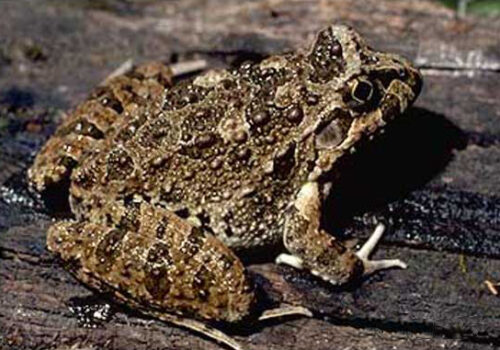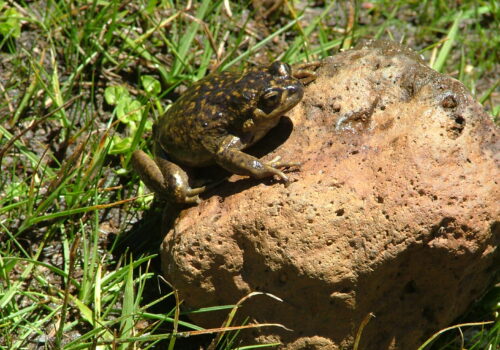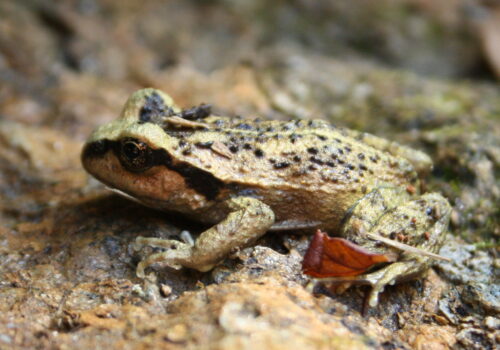- Exploring the Secretive World of Alsodes igneus: Patagonia's Elusive Frog
Exploring the Secretive World of Alsodes igneus: Patagonia’s Elusive Frog#
Introduction#
Hidden within the lush, mist-covered forests of southern Chile, in the shadowy realms of Patagonia, dwells a small but intriguing amphibian known to science as Alsodes igneus. Remarkably rare and often overlooked, this enigmatic frog embodies the profound wonder hidden within Earth’s less-celebrated corners. Far from the spotlight typically shone on larger, more charismatic wildlife, Alsodes igneus offers a poignant reminder of the interconnected delicacy that exists beneath the foliage, stones, and streams of Patagonia’s freshwater habitats.
Commonly known simply as the Tolhuaca Spiny-chest Frog, its quiet existence belies a unique ecological significance. Shrouded in mystery, the species was described only recently, taking researchers by surprise due to its secluded habits and extraordinary adaptations. A creature primarily active at night, Alsodes igneus embodies the subtle beauty and quiet intrigue that only Nature’s less conspicuous marvels truly convey.
Taxonomy and Classification#
Belonging to the family Alsodidae, the genus Alsodes comprises a group of frogs predominantly distributed across temperate South America. First officially described and scientifically named in 2003, Alsodes igneus is one of the lesser-known representatives of its genus, highlighting the continuous journey of biological exploration and discovery in this rugged, remote landscape.
The specific epithet “igneus”, meaning “fiery” in Latin, intriguingly references its known locality near the active Tolhuaca volcano in Chile’s Araucanía region, hinting at a fascinating habitat association rarely witnessed among amphibians. Despite having close evolutionary ties with other species of the Alsodes genus, our fiery amphibian stands apart not merely by proximity to volcanic activity but through subtle yet vital physiological and morphological adaptations.
Natural Habitat#
A Home in the Andes#
Confined narrowly to the southern Andean foothills of Chile, particularly around the Tolhuaca National Park and its surrounding valleys, Alsodes igneus has carved out a remarkable niche. Clear mountain streams, moist humus-laden undergrowth, and tree-lined watersides provide essential refuge for these frogs, allowing them to remain largely undetected even by seasoned naturalists.
The geography here—characterized by dense Valdivian temperate forests enveloped in near-constant mist—affords a cool, humid climate ideally suited to amphibians. Rain-soaked soils, dense mosses, and decaying leaf litter form an intricate ecosystem supporting numerous insects and invertebrates, perfect prey for the discerning, solitary palate of Alsodes igneus. This special biome, sculpted by volcanic activity, abundant rainfall, and ancient glaciation, is a delicate balance maintained by myriad interactions, among which Alsodes igneus plays a quiet yet indispensable role.
Habitat Preferences and Microhabitats#
Specializing in small streams and microhabitats sheltered beneath moss-covered rocks and rotting logs, these frogs require cool, clean waters to thrive. Their presence acts as an important indicator of stream ecosystem health. Intriguingly, evidence suggests subtle volcanic activity may influence their habitat choices, underscoring a fascinating ecological marvel where geology intersects biology. For this amphibian species, volcano-formed habitats provide unique factors—offering stable temperatures and protected breeding grounds, far from the reach of many predators.
Physical Characteristics#
Appearance and Size#
Captivating yet understated, Alsodes igneus is petite, measuring no more than 50 millimeters in length, with females generally slightly larger than males. Their small bodies boast earthy, camouflage tones—shades of olive-green, brown, and sometimes muted ochre—that blend seamlessly with Patagonia’s damp, forest floors. Long, thin limbs, adapted perfectly for leaping across slippery streambeds, lend them agility and grace rare among amphibians of such discreet appearance.
Adaptive Features#
A distinguishing trait of these frogs lies in their rough-textured skin, interspersed with minute, keratinous projections giving rise to the moniker “Spiny-chest.” This adaptation not only provides effective camouflage among mosses and lichens but may serve an understated defensive purpose, deterring smaller predators and parasites. Their cryptic coloration and texture genuinely exemplify evolutionary ingenuity in action, protecting them in an intricate tapestry of interwoven survival strategies.
Behavior and Life Cycle#
Nocturnal Lifestyle and Feeding Habits#
Under the protective shroud of darkness, Alsodes igneus emerges from daytime shelters to actively forage. Its diet consists largely of local insects, arachnids, and small freshwater invertebrates, hunted quietly and methodically. Equipped with keen night vision and a sensitive sense of touch, it easily locates prey hidden beneath moist foliage, often relying on surprise and rapid bursts of agility rather than prolonged pursuit.
Breeding and Development#
The breeding calls of Alsodes igneus males are subtle, a stark contrast to the loud, orchestral choruses typical among many frog species. Instead, these frogs exhibit restrained calls to attract females, maintaining secrecy essential to survival in an environment rife with predators. Breeding occurs during Chile’s spring and early summer months when snowmelt feeds mountain streams, offering perfect aquatic habitats for eggs and tadpoles. Eggs are deposited in sheltered pools or beneath submerged rocks, safeguarded by their cryptic location.
Developmental timing is synchronized with seasonal conditions, with hatched tadpoles quickly adapting to the buffered stream conditions. Streamlined bodies allow efficient maneuvering through current flows, whenever necessary seeking refuge amongst plant debris and small stones. Survival in these mountain waters demands adaptability; the species exemplifies a balanced and resilient developmental cycle attuned exquisitely and elegantly with local climatic challenges.
Ecological Role#
Serving as both a predator and prey within Patagonia’s freshwater systems, Alsodes igneus occupies a key ecological niche. Tadpoles contribute materially toward nutrient cycling, consuming algae and other microorganisms flourishing within clear mountain streams. Adults regulate insect populations, thereby maintaining ecological homeostasis among surrounding ecosystems.
Additionally, through serving as prey for larger animals, including birds, snakes, and small mammals, this modest amphibian forms an essential link in Patagonia’s delicate trophic chains. Their role as bioindicators is central: the species’ sensitivity towards habitat alterations places them at the forefront of ecological monitoring. Any environmental disturbance affecting these frogs serves as an early alarm, a sentinel voice urging us toward action and conservation.
Threats and Conservation Status#
Habitat Loss, Climate Change, and Disease#
Alsodes igneus currently faces increasing vulnerabilities driven by human-induced threats. Forest reductions from logging operations, pollution from nearby agriculture, and subtle climate shifts impacting stream temperatures and rainfall patterns threaten the delicate ecological balance underpinning their existence. Additional threats such as disease, notably the chytrid fungus implicated in global amphibian declines, loom large, posing significant conservation challenges.
IUCN Status and Conservation Efforts#
Today, Alsodes igneus holds a categorization as “Endangered” on the International Union for Conservation of Nature (IUCN) Red List, underscoring the urgency of conservation measures. Local environmental organizations and researchers are increasingly advocating habitat protections, improving stream quality, and establishing sanctuaries dedicated solely to supporting this fragile species.
Cultural and Scientific Significance#
Beyond ecological connections, frogs such as Alsodes igneus have traditionally played fascinating roles in human imagination. Indigenous Mapuche traditions perceive frogs as symbols of rain, renewal, and the health of the natural world, amplifying their significance within cultural landscapes. From a scientific perspective, studying Alsodes igneus gives crucial insights into evolutionary adaptation, conservation biology, and ecological resilience in vulnerable biodiversity hotspots.
Conclusion: Guardians of Patagonia’s Hidden Streams#
Alsodes igneus encapsulates the quiet marvel of amphibious life thriving secretly within Patagonia’s vibrant ecosystems. Understanding its life and conservation struggles gives us a greater appreciation for Nature’s intricacies and interconnectedness. Let us recognize this amphibian sentinel for what it truly is—an essential guardian of Patagonia’s freshwater realms. Only through greater awareness, informed conservation efforts, and dedicated protection can we ensure that the whispered croaks of Alsodes igneus continue resonating through Patagonia’s twilight forests for generations to come.










